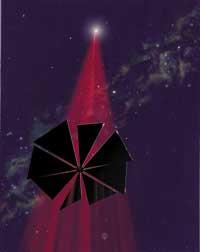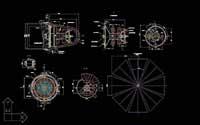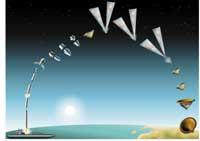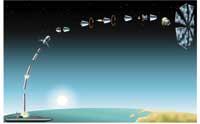Sailboats in the space

As he has done at sea, man has tried to navigate through space. In fact, scientists are trying to turn this idea into a feasible project since the mid-seventies. NASA, ESA and the Russian Space Agency are implementing technological development plans to meet this goal. However, the private entity The Planetary Society will be the one to take its first steps this month. The results obtained will be accessible to large space agencies in their projects.
The two common objectives of transport systems are speed and reduction of energy consumption. Many times there is no possibility of having both. At sea, for example, the fastest consume a lot of energy. The opposite is also true, in the case of sailboats. They are slow, but they are suitable for long trips. This same idea can be applicable to travel in space. But it has an important difference, it is a system that reaches high speeds in very long trips.
The spacecraft will be navigated with extended candles or fins of high reflectance materials. Theoretically calculate the objective of the mission

to know if everything is viable. To do this, the Planetary Society will put Cosmos 1 into orbit and will attempt to propel it through sunlight.
The mission will have two flights. In the first, in the half-hour flight from the sea of Barents to the peninsula of Kamchatka, the mechanism of expansion and stiffness of the fins will be demonstrated. This flight will take place at the end of April and will be carried out by boat with two wings. In the second flight, starting in October, the main objective will be to increase orbital velocity by impulse of sunlight. For this test the container will have eight blades. Once opened the eight, it will have 30 meters of diameter and 600 square meters of surface.

Russia's political situation in the launch of Cosmos 1 has been very satisfactory. As a result of the Cold War, many of the rockets that developed to be missiles are left over. These rockets are based on very advanced technology. An agreement was signed with the United States for the destruction of these weapons that were not used in civil and peaceful applications. The mission of space sailboats is one of these applications. The Volna rocket to be used for this mission will be launched from a submarine.
The results of this mission indicate that projects of sending probes to distant planets or nearby stars could be developed. But, for the moment, the fact that this means of transport dreamed of becomes reality has also generated a great passion for astronaut.
Physics of flight
Just as sailing ships are driven by the wind, photons emitted by the sun will be driven by the spacecraft. But how is it possible? What you need to know is that the thrust of navigation is not given by the solar wind. However, the containers will have the thrust of the photons. For this purpose, candles or fins are large, light mirrors.

Maritime navigation is possible by two factors. The first is wind, but with that it is not enough. To be able to control the boat is essential to control the water of the sea. In space the same occurs. The solar photons already mentioned will work the wind. In parallel, the ship's orbit will allow control of the journey.
In space all objects move in elliptic orbits. In orbits without eccentricity, circular, objects move at constant speed. As the eccentricity increases, the orbit becomes more elliptical and the velocity of the object depends on the position. Space navigation will be controlled by modifying orbital velocity. By decreasing the speed, the boat will head inward and, increasing, outward. In this way, the orbit of the container will be spiral.
Impulse of photons

Photons should collide with aspas. The photons have no mass at rest, but, like in the photoelectric effect, they have a kinetic moment at high speed and can push the container in case of collision. The strength obtained depends on the number of photons that attack the wing. The bigger the skin, the stronger it gets. In addition, the closer the sun is, the more photons are captured per square meter.
This force can be calculated from the power transmitted by photons to a surface. For example, a container of one kilogram of a 1,000 square meter cantilever located at the same distance from the earth's orbit would have an acceleration of 9.33 m/s2. Despite the strong acceleration, this calculation does not correspond to a real probe.
Today, however, space vessels of less than 5 g/m2 can be designed. The typical acceleration of this type of devices is 1.5 mm/s2. It is not a very large number for short distance travel, but it is ideal for going to distant planets. A Mars can go faster through conventional rockets, but with a higher energy consumption. Sailing offers two important advantages. On the one hand, it would have a controlled approach and, on the other, it would transport much greater loads.
Buletina
Bidali zure helbide elektronikoa eta jaso asteroko buletina zure sarrera-ontzian











